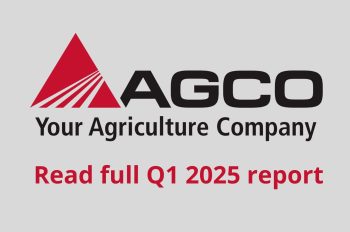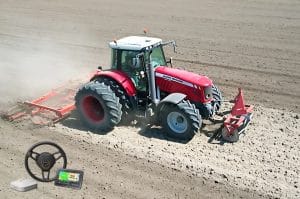AGCO reported net sales of $2.1 billion for the first quarter ended March 31, 2025, a decrease of 30.0% compared to the first quarter of 2024. Excluding unfavorable foreign currency translation of 2.4%, net sales in the quarter decreased 27.6% compared to the first quarter of 2024.
“AGCO performed well in the first quarter, which better positions us to navigate global trade uncertainties and continued weak industry demand,” said Eric Hansotia, AGCO’s Chairman, President and Chief Executive Officer. “We made substantial progress in our cost reduction efforts while reducing inventory by cutting production hours in the quarter by approximately 33% year-over-year. These decisive actions coupled with our focus on driving retail sales allowed us to improve dealer inventory levels in both North and South America.”
Hansotia continued, “We are seeing a mix of positive signs and risks around the world, requiring us to remain agile as we execute our Farmer-First strategy. The underlying fundamentals in many parts of the world have begun to trend upward with farmer sentiment in Europe improving, U.S. corn prices rising and corn stocks-to-use-ratios at lower levels. However, the global agricultural equipment market is volatile due to tariffs and shifting export demand for grain.”
Hansotia concluded, “As we look around the world, the U.S. may face reduced market access for key exports, while South America is likely to ship more to China. Although U.S. net farm income forecasts have been revised higher on government aid, increased subsidies are not expected to boost demand for farm equipment in the near term.
Brazil’s record soybean production and delayed corn planting highlight both growth potential and risks. Persistent rain and poor growing conditions have negatively impacted wheat production across Western Europe with reduced yields reported in several countries. Demand for new equipment has softened further in North America and Europe as a result of volatile crop producer demand.”
North American industry retail tractor sales decreased 14% during the first three months of 2025 compared to the first three months of 2024. Sales declines were relatively consistent across the horsepower categories with higher horsepower categories declining more in recent months. Combine unit sales were down 46% in the first three months of 2025 compared to the same period in 2024. Uncertain demand for grain exports and high input costs are expected to pressure industry demand in 2025, leading to weaker North American sales compared to 2024, particularly in larger equipment.
Brazil industry retail tractor sales increased 11% during the first three months of 2025 compared to the first three months of 2024, primarily in the smaller tractor categories. Despite record soybean harvests and potential trade benefits, we have not seen meaningful improved demand for larger equipment yet. If increased trade benefits farm economics, we could see improved demand later in the year. For now, we expect industry demand in Brazil to improve modestly in 2025.
In Western Europe, industry retail tractor sales decreased 17% during the first three months of 2025 compared to the first three months of 2024 with more significant declines in France, the United Kingdom and Germany. Industry demand is expected to remain soft in 2025 as lower income levels pressure demand from arable farmers, while healthy demand from dairy and livestock producers is expected to mitigate some of the decline.
As previously announced, AGCO’s net sales for 2025 are expected to be approximately $9.6 billion, reflecting lower sales volumes and assumed actions to mitigate tariff impacts. Adjusted operating margins are projected to be 7% – 7.5%, reflecting the impact of lower sales, lower production volumes, increased cost controls and flat engineering expenses. Based on these assumptions, 2025 earnings per share are targeted at $4.00 – $4.50. These full-year estimates reflect the projected impact of tariffs in place as of May 1, 2025 across the Company’s various
jurisdictions along with our planned mitigation actions. Changes to the tariffs or other actions in response to them could result in changes to these estimates.

![RightSpot Ad Template Digital-1400×190-px[76] Ag Leader RightSpot](https://world-agritech.com/wp-content/uploads/elementor/thumbs/RightSpot-Ad-Template-Digital-1400x190-px76-r316mmc0hgoob9qxmklllnnbxta1nlj7t2vjkoyeek.png)









